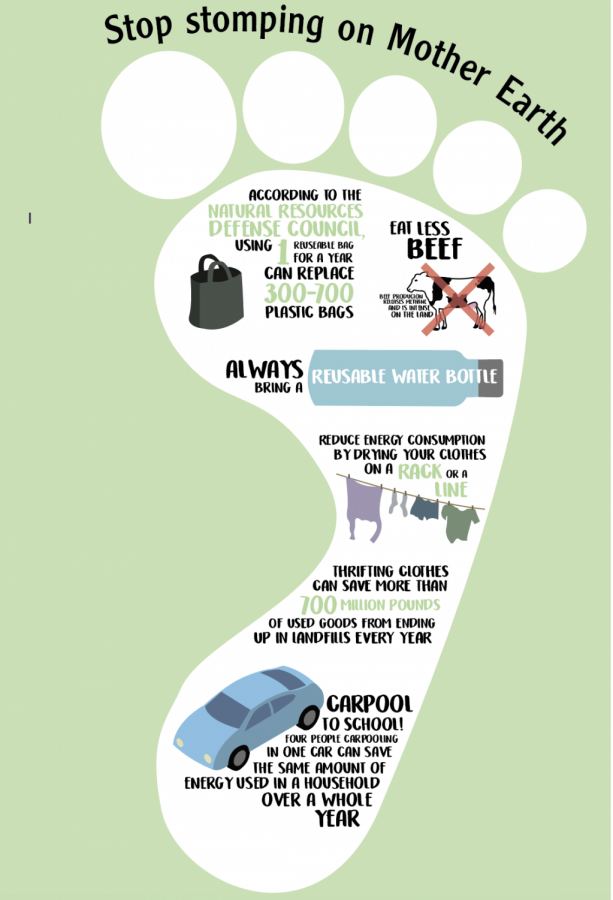Stop Stomping On Mother Earth
Ways to reduce your carbon footprint
Photo By Jane Snider
Graphic by Jane Snider
Carbon emissions are greenhouse gases that are destroying ecosystems and are harming the Earth. Humans are the cause of this and each person’s contribution to further warming the planet is defined as their carbon footprint.
Each individual can reduce their carbon footprint and slow down the process of global warming with simple day-to-day actions, like carpooling. On the other hand, people can make more drastic changes to their life by becoming a zero waster.
Saving water is also a way to decrease global warming. Taking shorter showers and turning off the faucet while brushing your teeth are just some small ways to cut down your water use.
“I use tupperware instead of plastic bags and my house has solar panels,” said freshman Elly Gossett. “I also try to limit my houses’ water usage by taking shorter showers and I just planted a garden to help reduce the amount of carbon going into the world.”
Conserving energy can be difficult but is important in reducing your carbon footprint. When the air conditioning or heater is on, keep doors and windows closed. Carpooling is one of the easiest ways to help with the environment as well as trying to walk instead of using a vehicle in the first place.
“To help reduce my carbon footprint, I use reusable straws and I will bike to some places where I would usually drive,” said junior Natalie Link. “Another thing I do is recycle and compost, that way not everything goes into the landfill.”
Plastic is one huge piece that is rising carbon emissions. Using a reusable water bottle is the most popular way to reduce one’s use of plastic bottles. In a poll, 93 percent of students use a reusable water bottle.
“Reusable water bottles are the smartest way to go,” said senior Nick Vasquez. “They reduce your carbon footprint and can also allow you to express yourself which I think is pretty cool.”
Learning and acting on the five R’s is a vital key to helping the planet. The five R’s include: Refuse, Reduce, Reuse, Rot and Recycle.
Refusing could be tough for some people but it really isn’t the hardest to remember. Someone that wanted to act off of refuse would avoid all single-use plastics and use plastics that can be reused.
The second ‘R’ is Reduce and it has to do a lot with being mindful of what waste is created each day. Make sure that what you purchase is being used and not being thrown out.
Reusing is very important because it decreases the amount of waste that ends up in landfills. Upcycling, repairing and changing an item helps reduce the waste that people create overall.
The largest ‘R’ of them all is Rot. This ‘R’ requires more thought and commitment than the other ‘Rs’. Rot is the act of setting up and using a compost pile.
The last of the five R’s is Recycle. Recycling as much as one can is key if you cannot reuse, reduce or rot. “I think it is very important that we do anything we can, big or small, to reduce our carbon footprint on this Earth,” said Gossett.
Life on Earth is endangered because humans aren’t taking action to reduce their carbon footprint. Everyone has the ability to reduce their own carbon footprint, it’s just a matter of if they will.































